Famous Sites and Festivals in Kyotanabe 京田辺市(きょうたなべし)で の 有名(ゆうめい)な 所(ところ) と イベント
- [2018年2月28日]
- ID:627
ソーシャルサイトへのリンクは別ウィンドウで開きます
Shūon-an (Ikkyūji Temple) and Takigi Noh 酬恩庵(しゅうおんあん) (一休寺(いっきゅうじ)) と 薪(たきぎ) の 能(のう)
Shūon-an (Ikkyūji Temple) was rebuilt in the 15th century by one of the most famous Buddhist priests in Japanese history, Ikkyū. A treasure trove of cultural heritage, it attracts many visitors.
With a main hall building from the Edo Period, wooden statue of a seated Ikkyū from the Muromachi Period (both designated national cultural assets) as well as a beautiful dry landscape garden on the temple grounds, there is plenty to see!
The temple is also known for staging the Takigi Noh. Performed every autumn on the night of a full moon, it transports its viewers to a mystical world.
酬恩庵(しゅうおんあん)は、 日本(にほん) の 歴史(れきし) の 中(なか)で 最(もっと)も 有名(ゆうめい)な 僧侶(そうりょ)〈お寺(てら)を 管理(かんり)している 人(ひと)〉の 1人(ひとり)で ある 一休(いっきゅう) 禅師(ぜんじ)が 15世紀(せいき)に 作(つく)り 直(なお)した お寺(てら) です。 この お寺(てら)は とても 大事(だいじ)な 文化財(ぶんかざい)〈文化的(ぶんかてき)な ところ や 物(もの)〉なので、 お客(きゃく)さんが 多(おお)い です。 秋(あき)は 紅葉(もみじ)も 楽(たの)しむ ことが できます。
この お寺(てら) の 本堂(ほんどう) と 枯山水(かれさんすい) という 庭(にわ)は 江戸(えど) 時代(じだい) から 残(のこ)っている もの です。 そして、 木(き) から 作(つく)られた 一休(いっきゅう) 和尚(おしょう) の 像(ぞう)は 室町(むろまち) 時代(じだい) から 残(のこ)っている 国(くに) の 重要文化財(じゅうようぶんかざい)〈日本(にほん) の 大事(だいじ)な 文化的(ぶんかてき)な ところ や 物(もの)〉 です。
毎年(まいとし) 秋(あき) の 満月(まんげつ)〈月(つき) の 全部(ぜんぶ)を 見(み)る ことが できる 時(とき)〉 の 頃(ころ)に この お寺(てら)で 行(おこ)われる 薪能(たきぎのう) という 伝統(でんとう) 演技(えんぎ)が 人気(にんき) です。
Ōmido Kannonji Temple and Nigatsudō Takeokuri 大御堂観音寺(おおみどうかんのんじ) と 二月堂(にがつどう)竹送(たけおく)り
Built in the Asuka Period, Kannonji Temple was until the Muromachi Period one of many buildings that made up a large Buddhist temple. It is famous for its cherry blossom and nanohana (rape blossom) in the spring and autumnal leaves in the fall.
Here you can see an 11-faced figure of Kannon made with wood-core dry lacquer from the Nara Period, which is a designated national treasure. Representative of Buddhist sculptures from the Nara Period, the realistic style and gentle face of this sculpture is impressive to many viewers.
The Takeokuri (Bamboo-Sending Festival) which occurs every year in February also brings many people to the area. The bamboo itself is for the “Omizutori” (Water Ceremony) held by Shunie of Todaiji Nigestudo in Nara. The bamboo will be delievered from Kyotanabe City to Nara City as the main activity of this event.
観音寺(かんのんじ)は 飛鳥(あすか) 時代(じだい)に 建(た)てられました。 この お寺(てら)は 室町(むろまち) 時代(じだい) までは たくさん の 建物(たてもの)が 建(た)ち 並(なら)ぶ 大(おお)きな お寺(てら) でした。 春(はる)は 桜(さくら)と 菜(な)の花(はな)、 秋(あき)は 紅葉(もみじ)が 有名(ゆうめい) です。
ここでは、 奈良(なら) 時代(じだい)に 作(つく)られた「木心乾漆造(もくしんかんしつづくり)十一面観音立像(じゅういちめんかんのんりゅうぞう)」 という 国宝(こくほう)〈日本(にほん) の 政府(せいふ)が 大事(だいじ) と 言(い)われた こと〉を 見(み)る ことが できます。
毎年(まいとし) 2月(がつ)に、 東大寺(とうだいじ) 二月堂(にがつどう)〈奈良市(ならし)に ある お寺(てら)〉 の 伝統(でんとう) 行事(ぎょうじ)〈イベント〉に 使(つか)う竹(たけ)を 運(はこ)ぶ、「竹送(たけおく)り」を します。 たくさん 人(ひと)が 参加(さんか)します。
Juhōji Temple 寿宝寺(じゅほうじ)
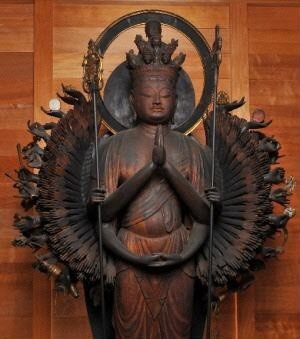
Built in the Asuka Period, this temple was originally one of many buildings that made up a large Buddhist temple.
Here you can see a sculpture of a wooden thousand-armed Kannon which is a designated cultural asset from the Heian Period. Carved from wood, many come to see the sculpture, as a figure with this many arms is rare in Japan.
寿宝寺(じゅほうじ)は 飛鳥(あすか) 時代(じだい)に 建(た)てられました。 この お寺(てら)は 昔(むかし) たくさん の 建物(たてもの)が 立(た)ち 並(なら)ぶ 大(おお)きな お寺(てら) でした。
ここでは、 重要(じゅうよう) 文化財(ぶんかざい)〈文化的(ぶんかてき)な ところ や 物(もの)〉で ある、平安(へいあん) 時代(じだい) の 「木造(もくぞう) 千手観音立像(せんじゅかんのんりゅうぞう」を 見(み)る ことが できます。 この 像(ぞう)は 約(やく) 千本(せんぼん) の 手(て)が あります。 日本(にほん) でも 珍(めずら)しい もので、 たくさん 人(ひと)が 見(み)に 来(き)ます。
Shuchi Shrine 朱智神社(しゅちじんじゃ)
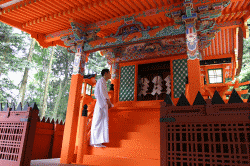
Tucked away deep in the mountains, this shrine is said to be the former shrine of the god of the Yasaka Shrine in Kyoto.
The brightly decorated main hall building was built originally in the Edo Period and is recognised as one of Kyoto prefecture’s registered cultural assets. Although it is not open to public, inside the temple is another official cultural asset of Kyoto prefecture, a wooden statue of Gozu Tennō (Buddhist deity with the head of a cow). This statue is representative tracing back to the Heian Period, and is famous in Japan for its angry expression.
朱智神社(しゅちじんじゃ)は 山(やま) の 奥(おく)にあります。 京都(きょうと) の 八坂神社(やさかじんじゃ)の 元(もと) となった 神社(じんじゃ)とも 言(い)われています。
ここでは、 輝(かがや)かしい 色(いろ)が 付(つ)いている 江戸(えど)時代(じだい)に 作(つく)られた 本殿(ほんでん)〈お寺(てら) の 中心(ちゅうしん)〉を 見(み)る ことが できます。 京都府(きょうとふ) の 文化的(ぶんかてき)な ところ です。 また、 一般(いっぱん) の 人(ひと)は 見(み)る ことが できませんが、 平安(へいあん) 時代(じだい) の 「木造(もくぞう) 牛頭天王立像(こずてんのうりゅうぞう)〈牛(うし) の 頭(あたま)が ある 仏教(ぶっきょう) の 神(かみ)〉」が あります。 この 像(ぞう)は 怒(おこ)っている 顔(かお)で 知(し)られています。 日本(にほん)に とって 大事(だいじ)な 像(ぞう)です。
Hōsenji Temple 法泉寺(ほうせんじ)
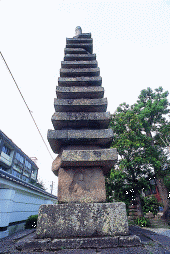
This temple was used for many years as a place where people prayed for rain and a good harvest. Here you can see a 13-level pagoda from the Kamakura Period which is a designated national cultural asset. Six metres high, it has proved to be a solid construction having endured many harsh winters.
法泉寺(ほうせんじ)は 作物(さくもつ)〈野菜(やさい) など 食(た)べる ことが できる 植物(しょくぶつ)〉が よく 育(そだ)つ ように 雨(あめ)が 降(ふ)る ように お願(ねが)い する ため の お寺(てら) として 有名(ゆうめい) です。 ここでは、 国(くに) の 重要(じゅうよう) 文化財(ぶんかざい)〈文化的(ぶんかてき)な ところ や 物(もの)〉である、 鎌倉(かまくら) 時代(じだい) の 石(いし) から 造(つく)られた 13重(じゅう)〈段(だん)〉が ある 塔(とう)が あります。 この 塔(とう) の 高(たか)さは 6メートル です。
Ōsumi Kurumazuka Kōfun 大住車塚古墳(おおすみくるまづかこふん)
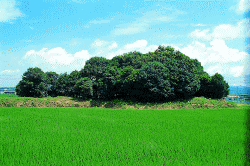
The Ōsumi Kurumazuka Kōfun is tomb from the Kōfun Period and has been appointed as an historical site in Japan. This important cultural asset measures approximately 66 metres in length and is a “two conjoined rectangles” style tomb.
Opposite of it to the south is another tomb which measures approximately 70 metres in length and is called the Ōsumi Minamizuka Kōfun. The view of the two tombs of similar sizes lying in the rice fields is very beautiful.
大住車塚古墳※(おおすみくるまづかこふん)は 国(くに) の 史跡(しせき)で ある 古墳(こふん) 時代(じだい) の 古墳(こふん) です。 この 古墳(こふん) の 長(なが)さは 約(やく) 66メートル です。 「前方後方墳(ぜんぽうこうほうふん)」 と 呼(よ)ばれる 2つ の 四角(しかく)を つなぎ合(あ)わせた 形(かたち)を しています。
南(みなみ) 隣(とな)りには、 大住南塚古墳(おおすみみなみづかこふん)も あります。 長(なが)さは 約(やく) 70メートル です。 水田(すいでん) の 中(なか)に、 同(おな)じ 程度(ていど) の 古墳(こふん)が 並(なら)ぶ 景色(けしき)は とても きれいです。
※古墳(こふん) とは、昔(むかし) の お墓(はか)です。
Mitsumanbo Aqueduct ミツマンボ
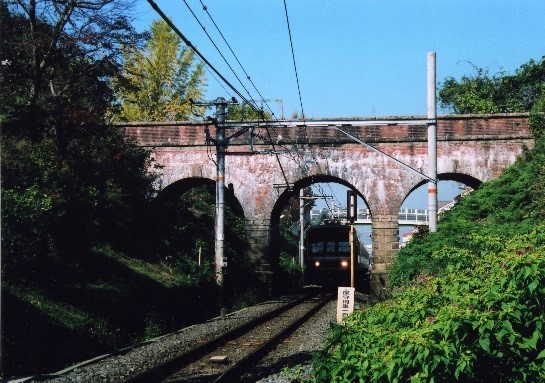
Around Kyotanabe City there are many rivers that have been built higher up than ground level. The bridges of the canal system that let the river pass above railways and roads are called “manbo”. One of the most famous manbo is the impressive-looking “Mitsumambo”, located to the east of the Tanabe Elementary school.
京田辺市(きょうたなべし)には、 「天井川(てんじょうがわ)」 と 呼(よ)ばれる、 周(まわ)り の 平地(へいち)〈山 や 坂が ない ところ〉よりも 高(たか)くなった 川(かわ)が いくつか あります。「 天井川(てんじょうがわ)」を 線路(せんろ) や 道路(どうろ) の 上(うえ)を 通(とお)す ために 造(つく)られた 水路橋(すいろばし) の トンネルを 「マンボ」と 呼(よ)びます。 田辺小学校(たなべしょうがっこう) の 東側(ひがしがわ)には 三本(さんぼん) の トンネルを 持(も)つ 美(うつく)しい 赤煉瓦(あかれんが) から 作(つく)られている「ミツマンボ」が あります。
Grass-Ring Festival (Chinowa Kuguri) 茅(ち) の 輪(わ)くぐり
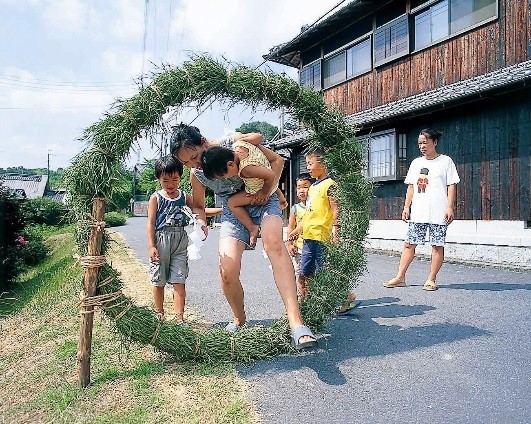
Although this festival is a not unique to Kyotanabe, unlike other shrines in Japan the Grass-Ring Festival in Miyanokuchi District takes place outside the shrine grounds. Every year in July, a ring measuring 1・6 metres in diameter is constructed out of bundled bamboo sticks and leaves and placed on road-side at the north-eastern edge of the district. It is believed that if you pass through the ring from the north side three times, you will be granted with perfect health to live on.
茅(ち) の 輪(わ)くぐりは どこ の 神社(じんじゃ)でも 見(み)る ことが できますが、 宮ノ口区(みやのくちく) の 茅(ち) の 輪(わ)くぐりは 神社(じんじゃ) の 土地(とち) の 外(そと)で 行(おこ)なわれる 珍(めずら)しい もの です。 毎年(まいとし) 7月(がつ)に、 笹(ささ) の 葉(は) の 付(つ)いた竹(たけ)を 束(たば)ねて、 約(やく) 1・6m の 輪(わ)を 作(つく)り、 宮ノ口区(みやのくちく) の 東北側(とうほくがわ) の 道(みち)に 置(お)きます。 茅(ち) の 輪(わ)を 北側(きたがわ) から 3回(かい) くぐると、 病気(びょうき)に ならず 健康(けんこう)で 過(す)ごす ことが できる とされます。
Saga Shrine and Yamamoto Hyakumi To Yudate 佐牙神社(さがじんじゃ) と 山本(やまもと) の 百味(ひゃくみ) と 湯立(ゆだて)
The Saga Shrine has an ancient history. Re-built in the Azuchi-Momoyama period, its main hall is a designated national cultural asset.
Every October the shrine’s festival “Yamamoto Hyakumi To Yudate” takes place at the temporary shrine located inside the Saga Shrine of Yamamoto District.
Once the portable shrine arrives at Saga Shrine, believers will offer the “Hyakumi” (100 "tastes" of various vegetables, beans/nuts, and fruits) that they gathered for the God. Worshipers will then eat these foods as hand-me-downs from the gods. At night, a ritual called “Yudate Kagura” is performed at the front garden of the portable shrine.
Water is boiled in a large pot as shrine maidens play hand bells and drums while they perform a ceremonial dance. In conclusion of the ceremony, bamboo leaves are used to sprinkle the water on spectators to grant them peace and good health.
Many people come to see the bright and colourful display of the Hyakumi and experience the dynamic Yudate ritual in Yamamoto, which are both official intangible folk cultural assets Japan.
安土桃山(あづちももやま) 時代(じだい)に 建(た)て 直(なお)された 佐牙神社(さがじんじゃ)は 本殿(ほんてん)〈神社(じんじゃ) の 中心(ちゅうしん)〉が 国(くに) の 重要(じゅうよう) 文化財(ぶんかざい)〈文化的(ぶんかてき)な ところ や 物(もの)〉です。
毎年(まいとし) 10月(がつ)には、 山本地区(やまもとちく) の 佐牙神社(さがじんじゃ) 御旅所(おたびしょ)〈一時的(いちじてき)な 神社(じんじゃ)〉で 「山本(やまもと) の 百味(ひゃくみ) と 湯立(ゆだて)」が 行(おこな)われます。
佐牙神社(さがじんじゃ) から 神輿(みこし)〈運(はこ)ぶ ことが できる 小(ちい)さな 神社(じんじゃ)〉が 着(つ)く と、 参加者(さんかしゃ)が 集(あつ)めた 野菜(やさい)、 豆(まめ)、 果物(くだもの) など の 「百味(ひゃくみ)」を 神(かみ)に 供(そな)えます〈挙(あ)げる〉。そして、 参加者(さんかしゃ)が この 百味(ひゃくみ)を 食(た)べます。
夜(よる)には、 御旅所(おたびしょ) の 前(まえ) の 庭(にわ)で 湯立神楽「(ゆだてかぐら)」を します。 釜(かま)に お湯(ゆ)を わかし、 巫女(みこ)が 「神楽(かぐら)」を 踊(おど)り ながら、 鉦(かね) と 太鼓(たいこ)を 打(う)ちます。 参加(さんか) の 人(ひと)たちが 病気(びょうき)せず 健康(けんこう)で ある ことを 願(ねが)う ため、 巫女(みこ)が 神笹(かみささ)で お湯(ゆ)を ふりかけます。
山本(やまもと) の 百味(ひゃくみ) と 湯立(ゆだて)は 京田辺市(きょうたなべし) の 無形民俗文化財(むけいみんぞくぶんかざい)〈文化的(ぶんかてき)なところや物(もの)〉です。 たくさん の 人(ひと)が、 百味(ひゃくみ) の きれいな 色(いろ) と 湯立(ゆだて)を 見(み)に 来(き)ます。
Tsukiyomi Shrine and Ōsumi Hayato Mai 月読神社(つきよみじんじゃ) と 大住隼人舞(おおすみはやとまい)
Every year on 14th October a dance ritual called the Ōsumi Hayato Mai is performed at the Tsukiyomi Shrine.
Ōsumi Hayato Mai is a ritual that was brought by the Ōsumi Hayato people who moved to this area from Southern Kyushu in the Asuka Period. This dance which was originally performed in front of the imperial court, has been taken up again in recent years and is now an official intangible folk cultural asset of Japan. Nowadays, the dance is performed by school students (6 dances performed by junior high school students, and 1 dance performed by elementary school students). Many people gather every year to see this event.
月読神社(つきよみじんじゃ)では、 毎年(まいとし) 10月(がつ) 14日(にち)に 月読神社(つきよみじんじゃ)で 大住隼人舞(おおすみはやとまい) という 踊(おど)りを します。〈舞(まい)=踊(おど)り〉
大住隼人舞(おおすみはやとまい)は、 飛鳥(あすか) 時代(じだい)に 九州(きゅうしゅう) 南部(なんぶ) から ここに 引(ひ)っ越(こ)した 「大隅隼人(おおすみはやと)」 という 人(ひと)が 天皇(てんのう) の 前(まえ)で 踊(おど)った 踊(おど)り です。 近年(きんねん)、 この 踊(おど)りを また踊(おど)る よう になり、 市(し) の 無形民俗文化財(むけいみんぞくぶんかざい)〈文化的(ぶんかてき)な ところ や 物(もの)〉 です。 中学生(ちゅうがくせい)は 6種類(しゅるい) の 踊(おど)りを 踊(おど)ります。 小学生(しょうがくせい)は 1種類(しゅうるい) の 踊(おど)りを 踊(おど)ります。 毎年(まいとし)、 たくさん の 人(ひと)が この 踊(おど)りを 見(み)に 来(き)ます。
Tanakurahiko Shrine and Zuiki Mikoshi 棚倉孫神社(たなくらひこじんじゃ) と 瑞饋神輿(ずいきみこし)
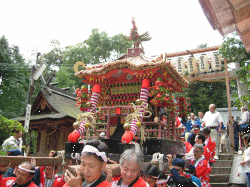
The Tanakurahiko Shrine is famous for its main hall building which was re-built during the Azuchi-Momoyama Period and is a designated cultural asset of Kyoto Prefecture.
Every two years in October, to celebrate the Autumn harvest, a portable shrine called a "Mikoshi" is decorated with around 30 different varieties of vegetables and grains such as red zuiki (taro stems) for the roof, green zuiki for the torii (Shinto shrine gateway), and others like peppers, red eggplants, and chrysanthemums. This decorated shrine is then paraded around the area for the “Zuiki Mikoshi” ritual. The Zuiki Mikoshi is an official intangible folk cultural asset of the city. On the day of the festival many people come to see the procession.
棚倉孫神社(たなくらひこじんじゃ) の 本殿(ほんてん)〈神社(じんじゃ) の 中心(ちゅうしん)〉は 安土桃山(あづちももやま) 時代(じだい)に 建(た)て 直(なお)されました。 京都府(きょうとふ) の 登録文化財(とうろくぶんかざい)〈文化的(ぶんかてき)な ところ や 物(もの)〉 です。
棚倉孫神社(たなくらひこじんじゃ)では 2年(ねん)に 1度(ど) の 10月(がつ)に、 秋(あき)に 田(た)んぼ や 畑(はたけ)で たくさん 野菜(やさい) などが できる ように 願(ねが)います。 「神輿(みこし)」 という 運(はこ)ぶ ことが できる 小(ちい)さな 神社(じんじゃ) の 屋根(やね)に 赤ズイキ、 鳥居(とりい)に 青ズイキ、 と 全体(ぜんたい)に 唐辛子(とうがらし) や 赤(あか)なす、 菊(きく)の花(はな)、 大豆(だいず) など 全部(ぜんぶ)で 約(やく) 30種類(しゅるい) の 野菜(やさい) や 穀物(こくもつ)を 飾(かざ)ります。 そして、 この 神輿(みこし)〈瑞饋神輿(ずいきみこし) という 習慣(しゅうかん)〉が 地域(ちいき)を 巡(めぐ)ります。瑞饋神輿(ずいきみこし)は 市(し) の 無形民俗文化財(むけいみんぞくぶんかざい)〈文化的(ぶんかてき)な ところ や 物(もの)〉です。たくさん 人(ひと)が この お祭(まつ)りを 見(み)に 来(き)ます。
Sakaya Shrine 酒屋神社(さかやじんじゃ)
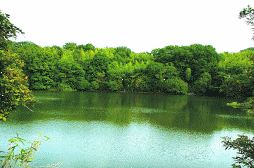
The establishment date of the Sakaya Shrine remains unknown as of today, however, according to the shrine history, it is said that the Empress Consort Jingū left sake barrels here as an offering to the gods before departing on an expedition to the Korean peninsula.
Today many people visit the temple to worship the gods of sake.
酒屋神社(さかやじんじゃ)は 建(た)てられた 年代(ねんだい) などが わかりません。 「神功(じんぐう)」 という 皇后(こうごう)〈天皇(てんのう) の (つま)〉が 「朝鮮半島(ちょうせんはんとう)」と いう ところに 行(い)く 前(まえ)に、 ここに 酒壺(さかつぼ)を 置(お)いたと 言(い)われています。 そのため、 今(いま)でも お酒(さけ) の 神様(かみさま) として、 人々(ひとびと)に 大切(たいせつ)に されています。
Sawai Family Residence 澤井家住宅(さわいけじゅうたく)
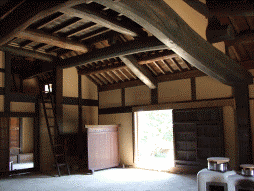
The Sawai Family Residence was built in the Edo Period. It was home to the magistrate who ruled over the Monzeki Donge-In territories. Today it is a designated national cultural asset.
Different from other houses of that era, this sophisticated-looking residence was solidly constructed with thick pillars and beams going through the building.
澤井家住宅(さわいけじゅうたく)は、 江戸(えど) 時代(じだい)に 建(た)てられた 家(いえ)で、 国(くに) の 重要文化財(じゅうようぶんかざい)〈文化的(ぶんかてき)な ところ や 物(もの)〉 です。 澤井家(さわいけ)は、 門跡曇華院門(もんぜきどんげいんもん) の 地域(ちいき)を 管理(かんり)した 家族(かぞく)でした。 この 家(いえ)は 同(おな)じ 時代(じだい) の 家(いえ)と 違(ちが)います。 太(ふと)い 柱(はしら) と 梁(はり)で 作られた、 立派(りっぱ)な 建物(たてもの) です。
Ino’oka Kōfuns 飯岡古墳群(いのおかこふんぐん)
In the great Ino’oka hills to the west of Kizugawa, lies several tombs from the 4th-6th century such as the Ino’oka Kurumazuka Kōfun and the Yakushiyama Kōfun.
The Ino’oka Kurumazuka Kōfun group, measuring 90 metres in length, is the biggest tomb in the city area. It is a “key-hole” style kōfun (has one square-shaped and one circular end). It is surrounded by beautiful tea fields which are included in the Japan Heritage project, “A Walk through the 800-year History of Japanese Tea” and is designated as a cultural asset.
From the summit of the Yakushiyama Kōfun, visitors can enjoy a spectacular view of the whole city.
木津川(きづがわ) の 西(にし)に ある 飯岡(いのおか) の 丘(おか)には、 飯岡車塚古墳(いのおかくるまづかこふん) や 薬師山古墳(やくしやまこふん) など、 4世紀(せいき) ~ 6世紀(せいき) の 古墳(こふん)が あります。
飯岡車塚古墳(いのおかくるまづかこふん) の 長(なが)さは 90メートルで、 京田辺市(きょうたなべし)で 一番(いちばん) 大(おお)きい 古墳(こうふん) です。 前方後円墳(ぜんぽうこうえんふん)と 呼(よ)ばれる 四角形(しかくけい) と 円形(えんけい)を つなぎ合(あ)わせた 形(かたち)を しています。 また、 飯岡古墳群(いのおかこふんぐん) の 周(まわ)りに 広(ひろ)がる 茶畑(ちゃばたけ) の 景色(けしき)は 美(うつく)しく、 文化庁(ぶんかちょう) の 日本(にほん) 遺産(いさん)「日本茶(にほんちゃ) 800年(ねん) の 歴史(れきし) 散歩(さんぽ)」 の 文化財(ぶんかざい)〈文化的(ぶんかてき)な ところ や 物(もの)〉 です。
また、 薬師山古墳(やくしやまこふん) の 上(うえ) から の 京田辺市(きょうたなべし)を よく 見(み)る ことが できます。
※古墳(こふん) とは、 昔(むかし) の お墓(はか) です。
※古墳群(こふんぐん) とは、 古墳(こふん) の 集(あつ)まり です。
